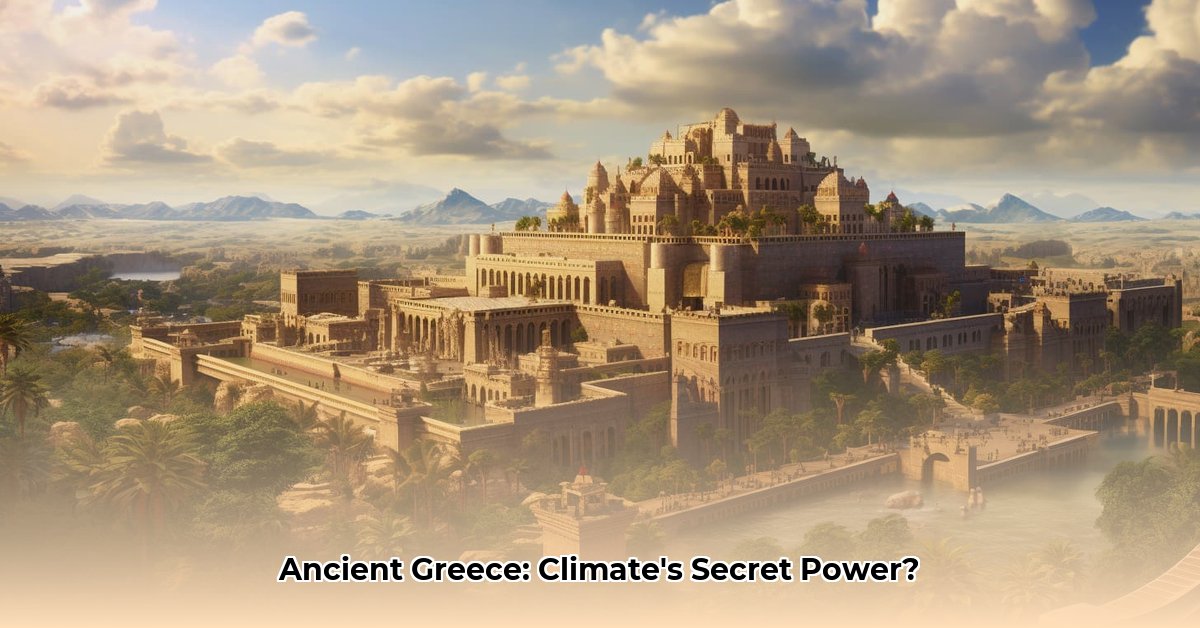Ever wonder what the weather was like in ancient Greece? It wasn’t always idyllic, sunny skies and olive groves. The climate played a huge role in shaping everything from the ancient Greeks’ diet to their societal structures, myths, and legends! This article delves into the surprisingly complex world of the ancient Greek climate, exploring regional climate differences, how it affected agriculture, and what we can learn from studying its past. We’ll examine the scientific methods used to understand the climate of long ago and consider how this ancient environment still influences us today. For more on the geography, check out this helpful resource on Ancient Greek geography. Get ready for a fascinating journey back in time – a trip that reveals how climate helped write the story of ancient Greece.
Ancient Climate and Civilization: Unveiling its Influence
Ancient Greece was more than just a land of myths and heroes; it was a place profoundly shaped by its weather and environment. Picture sun-drenched summers, gentle breezes whispering through olive groves, and winters mild enough to sustain life. That’s the Mediterranean climate in a nutshell, the backdrop against which Greek civilization unfolded. However, this seemingly idyllic setting presented challenges, creating a world of both opportunity and adversity.
The Mediterranean climate, characterized by hot, dry summers and relatively mild, wet winters, wasn’t uniform across the entire region. Imagine the stark difference between a sun-kissed coastal village and a high-altitude settlement nestled in the mountains. Coastal areas, moderated by the sea, generally enjoyed more consistent temperatures throughout the year. The sea acted as a giant temperature regulator, smoothing out the extremes of heat and cold. Inland and mountainous regions experienced cooler seasonal temperatures, sometimes drastically so, and more varied rainfall patterns. Some mountain valleys received abundant rainfall, while others experienced a “rain shadow” effect, remaining drier due to the mountains blocking rain clouds.
This diverse climate directly influenced agriculture, the lifeblood of ancient Greek society. The success of the year, from plentiful harvests to community stability, depended on winter rains. Sufficient rainfall meant flourishing crops, abundant food, and a thriving population. Insufficient rainfall, however, meant drought, crop failure, and potential famine. This climatic variability significantly impacted daily life.
Consider the staples of the ancient Greek diet: olives and grapes. These were more than ingredients; they were cornerstones of their economy and culture. These resilient plants thrived in the Mediterranean environment, providing oil, wine, and food. However, even these hardy plants suffered from intense summer heat and unpredictable rainfall. Farmers developed ingenious methods to manage the climate’s challenges, including specialized irrigation techniques and careful crop selection suitable for local conditions. Their success depended on understanding their local climates’ nuances.
Now, consider the broader societal impact. The availability (or scarcity) of arable land and water resources played a crucial role in shaping the political landscape. Imagine dozens of independent city-states, or poleis, fiercely competing for the most fertile land and reliable water sources. Frequent conflicts between these city-states may have stemmed from this constant resource struggle, heavily influenced by the climate’s unpredictable nature and pressure on agricultural systems. Prolonged droughts likely sparked social tensions and conflict within these independent communities.
It wasn’t just the regular pattern of seasons; extreme weather events also played a vital role. Heavy rainfall could cause devastating flash floods, wiping out entire harvests and settlements. Prolonged droughts brought hardship and famine, causing widespread social unrest. While precise records of these events are scarce, their impact on life in ancient Greece is clear. These events are even reflected in their mythology, where unpredictable weather influenced events and the temperaments of the gods.
The story also highlights the ancient Greeks’ incredible resilience and adaptability. They actively responded to the challenges posed by their climate. The architecture of ancient Greece, including the design of aqueducts and open-air theaters, demonstrates their understanding of climatic conditions and their ability to work with them, even to overcome them. Their agricultural practices and crop choices reveal a deep knowledge of their environment. They even utilized the reliable Etesian winds, predictable summer breezes, for navigation and irrigation.
The legacy of the ancient Greek climate is not just about environmental conditions; it’s about the human response. Their achievements, from agricultural breakthroughs to architectural marvels, demonstrate a remarkable ability to thrive. It’s a story of adaptation, innovation, and the profound influence of environment on civilization.
Unveiling Regional Climate Variations and Patterns
| Region | Rainfall Pattern | Temperature Profile | Dominant Crops | Challenges |
|---|---|---|---|---|
| Coastal Areas | Generally consistent, well-distributed | Moderate, moderated by sea breezes | Olives, grapes, grains, various fruits and vegetables | Occasional flooding, occasional mild winters |
| Inland Plains | More variable, prone to droughts | Hot summers, cooler winters | Grains, some olives & grapes | Droughts, intense heat |
| Mountainous Areas | Highly variable, rain shadow effects common | Cooler, more variable across elevations | Limited arable land, grazing, some hardy crops | Harsh winters, limited suitable land for farming |
This table highlights the significant regional variations within the broader Mediterranean climate of ancient Greece. These variations explain differences in agricultural methods, settlement patterns, and social structures that developed in those areas. Research continues into the precise climatic conditions of ancient Greece, and the data we have today is still being refined and analyzed. New discoveries and advanced methods will likely bring a greater understanding of the complex relationship between climate and ancient history.
Agriculture and Societal Structures in Ancient Greece
Key Takeaways:
- Ancient Greek agriculture thrived despite environmental limitations. Resourceful adaptations ensured relative food security.
- The Mediterranean climate, with its hot, dry summers and mild, wet winters, directly impacted farming techniques.
- Limited arable land and challenging terrain were major hurdles. Basic tools further hampered productivity.
The Mediterranean’s Embrace and Grip: A Climate-Defined Society
Imagine a land sculpted by sun-drenched summers and mild, rainy winters. This is the Mediterranean climate of ancient Greece—a landscape both bountiful and unforgiving. It dictated life, shaping agriculture and societal structures in profound ways. How did climate variations in ancient Greece affect agricultural practices and societal structures? This question is central to understanding ancient Greece’s story.
Farming Under the Greek Sun: Challenges and Innovations
Ancient Greek farmers faced a constant balancing act. Fertile land was scarce. Mountains and rocky terrain limited arable areas. Rainfall was irregular, a gamble each year. Tools were basic; irrigation, while present, was limited. These constraints forced innovation. They cleverly selected drought-resistant crops—olives, grapes, wheat, and barley became staples. Clever water management techniques like cisterns (underground reservoirs for storing rainwater, ensuring water supply during dry periods) and terracing maximized scarce resources. Crop rotation helped maintain soil health. Yet, despite these efforts, the climate remained a fickle master.
The Price of a Poor Harvest: Socioeconomic Impacts
Imagine a year of drought. Crop yields plummet. Food prices soar. This scenario was a recurring threat in ancient Greece. Food shortages and famines could lead to social unrest, political instability, and even conflict between city-states. Farmers, heavily reliant on the whims of nature, faced economic hardship. Economic dependence on agriculture meant a poor harvest affected the entire society. This climate-induced instability wasn’t just an agricultural crisis; it was a societal one.
Regional Differences and Their Impact
The Greek landscape wasn’t uniform. Climate varied regionally. Some areas experienced more rainfall than others. This diversity meant different agricultural strategies. Coastal regions might focus on fishing or specialized crops, while inland areas relied on cereal cultivation. This regional variation in climate created distinct agricultural and economic niches. It also impacted the overall economic strength and resilience of Greek civilization. A disaster in one region might only partially affect the entire country.
Lessons from the Past: Relevance to Modern Agriculture
The ingenuity of ancient Greek farmers offers lessons for us today. Their resourcefulness in the face of climate challenges presents remarkable parallels to the concerns of modern sustainable agriculture (farming practices that prioritize environmental conservation, soil health, and long-term productivity). Water conservation methods, diversification of crops, and mindful land management—these were not just ancient practices; they’re principles we still need to embrace. Ancient Greece serves as a cautionary tale too: the vulnerability of civilizations reliant on agriculture highlights the significance of climate resilience strategies (adaptations that help communities withstand climate change impacts).
https://www.worldhistory.org/article/113/food–agriculture-in-ancient-greece/
Ancient Greece Climate Comparisons: Regional Variations
Key Takeaways:
- Ancient Greece enjoyed a Mediterranean climate, but significant regional differences existed.
- This climatic variation profoundly impacted agriculture, societal structures, and even military campaigns.
- Reconstructing past climates relies on proxy data like pollen and tree rings, which present challenges in interpretation.
A Tapestry of Ancient Climates
Imagine a land sculpted by sun-drenched hills and shimmering seas. That’s ancient Greece—but its climate wasn’t uniform. From the sun-baked Peloponnese to the cooler, wetter north, diverse weather patterns shaped the lives of its inhabitants. Ancient Greece Climate Comparisons: Regional Variations are key to understanding this civilization.
The core climate was Mediterranean: hot, dry summers and mild, wet winters. Even within this framework, significant differences existed. Coastal regions enjoyed milder temperatures than inland areas. Higher elevations experienced cooler temperatures and more rainfall. These variations had profound effects on daily life, shaping the landscape as much as the people.
Agriculture: A Climate’s Effect
Agriculture was the lifeblood of ancient Greece, and climate determined which crops thrived where. The fertile plains of Thessaly, for instance, produced abundant grains, supporting large populations. Conversely, the drier regions of the Peloponnese were better suited to growing olives and grapes. The availability of water, dictated by rainfall patterns and proximity to rivers, deeply influenced agricultural practices. Irrigation systems, where feasible, became crucial for maximizing yields. These differing agricultural opportunities shaped economic disparities and regional specialization.
Society and the Seasons
Climate strongly affected the social fabric of ancient Greece. The long, hot summers dictated lifestyles. People spent significant time outdoors—markets bustled, festivals bloomed. However, harsh winters could disrupt trade and supply chains. Regional variations in climate also influenced the distribution of settlements. Population density often mirrored the land’s fertility, showing a visible link between climate and settlement patterns. Mountainous regions’ colder climates supported fewer people and different lifestyles compared to the coastal plains. The seasonal availability of resources shaped religious festivals and social gatherings.
The Unpredictability of Nature in Ancient Greece
Ancient Greeks were not immune to the whims of nature. Droughts, though not always evenly distributed, could devastate crops, leading to famine and social unrest. Extreme weather events like floods could disrupt settlements and trade routes and even trigger conflicts. The correlation between climatic shifts and major societal changes remains a subject of ongoing study. The challenges in accurately reconstructing these past events from fragmentary proxy data highlight the need for further, careful research.
Reconstructing the Past: Challenges and Insights
Understanding ancient Greece’s climate means interpreting diverse proxy data—pollen, tree rings, ice cores, and more. These provide glimpses into past conditions, but challenges exist. The resolution of these data sources varies; accurately dating events can be difficult. The interpretations are not always clear-cut, leading to debates over the extent of drought or the exactitude of temperature fluctuations. Yet, the insights they offer illuminate how climate variation affected daily life and regional development.
A Legacy of Adaptation
Ancient Greeks developed sophisticated strategies to adapt to their climate. Their architecture, from the thick walls of homes to courtyard designs, reflects strategies to combat summer heat. Water management systems—from cisterns to aqueducts—show ingenuity in harnessing resources. Such adaptation is a testament to human resilience in the face of environmental challenges. Their ingenuity in adapting to a highly varied climate offers valuable lessons even today.
Understanding Ancient Greece’s Agriculture: A Step-by-Step Guide
Key Takeaways:
- Ancient Greek agriculture thrived despite environmental challenges, showcasing remarkable adaptability.
- Olive, grape, and grain cultivation formed the backbone of their food production.
- Innovative techniques like terracing and crop rotation maximized resource use.
The Mediterranean Climate: A Double-Edged Sword
Ancient Greece’s climate, a Mediterranean type, presented both opportunities and limitations for its inhabitants. Warm, dry summers were ideal for sun-loving crops like olives and grapes. However, these same summers brought the ever-present threat of drought. Mild, wet winters offered a reprieve, but unpredictable rainfall could lead to crop failures. Imagine the anxiety of farmers relying on the capricious whims of nature! This climatic variability shaped every aspect of their agricultural practices.
Adapting to the Terrain: Terracing and Innovation
The landscape of ancient Greece is varied, characterized by mountains, hills, and valleys. Farming wasn’t just about planting seeds; it involved careful land management. Farmers ingeniously carved terraces into hillsides, creating level plots for cultivation. This wasn’t just about aesthetics; it maximized arable land and helped conserve precious water. This is a clear example of Understanding Ancient Greece’s Agriculture: A Step-by-Step Guide.
In addition to terracing, they practiced crop rotation, alternating crops to maintain soil fertility. They understood the importance of letting fields lie fallow (allowing farmland to rest without cultivation to restore its fertility) – a clever strategy to restore soil nutrients and prevent depletion. What innovative strategies might ancient Greek farmers devise if facing today’s climate challenges?
Crops and Livestock: A Symbiotic Relationship
Wheat and barley were staple grains, forming the basis of their diet. Olives and grapes provided oil and wine, crucial for trade and sustenance. But agriculture wasn’t solely about cultivating plants. Livestock played an important role, though its exact extent remains debated. Sheep and goats provided wool, milk, and meat. There’s evidence suggesting transhumance (the seasonal movement of livestock between different grazing altitudes) was also practiced.
Societal Impact: Myth, Religion, and Economy
Agriculture wasn’t just an economic activity; it was deeply intertwined with their culture and religion. Demeter, the goddess of agriculture, occupied a central place in their mythology, reflecting the profound importance they placed on farming. Agricultural cycles dictated their festivals, social structures, and even their artistic expressions. The success or failure of harvests directly impacted economic stability and political power.
Lessons for Today: Sustainability from the Past
Ancient Greek farmers faced similar challenges to those we face today: unpredictable weather, limited resources, and the need for sustainable practices. Their ingenuity in adapting to a harsh environment offers valuable lessons for modern agriculture. Their emphasis on soil health, water conservation, and integrated farming systems—practices we now broadly consider sustainable—deserves reevaluation and adaptation for today’s world. By studying their methods, we can glean valuable insights into building resilient and environmentally conscious agricultural systems.
- Discover Ancient Greek Furniture: A History of Design and Influence - August 12, 2025
- Explore the Marathon Ancient Greece Map: A New Perspective on the Iconic Battle - August 12, 2025
- Explore Ancient Greece Drawings: Styles, Periods and Enduring Examples - August 12, 2025















